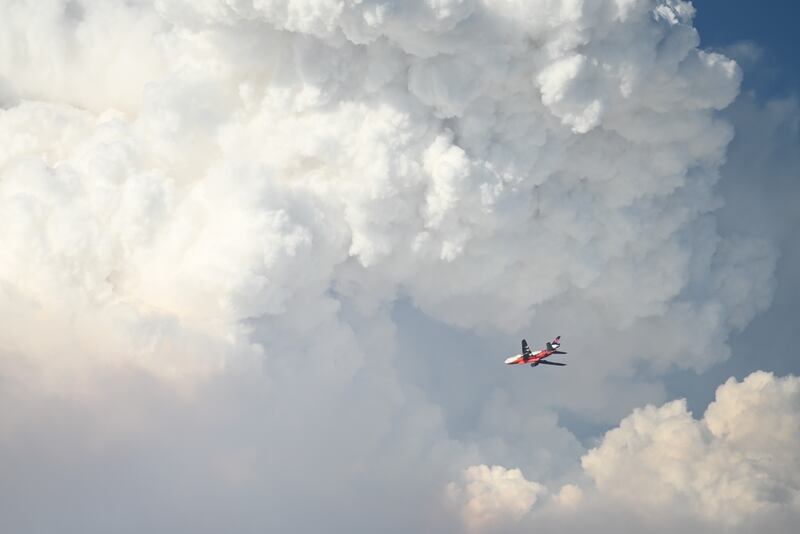On its fourth night fighting the Bootleg Fire, Portland Fire & Rescue’s brush truck died.
The brush trucks—red Ford F-550s with 300-gallon water tanks bolted to their beds—are the vehicles Portland firefighters use to reach blazes in places fire engines can’t go. These are the trucks PF&R uses when fireworks set a thicket ablaze. So when Multnomah County fire departments sent a convoy to Oregon’s southern border to fight one of the largest wildfires of the past two decades, that’s what Portland sent.
Just one problem: The trucks’ engines are choking on the dust of the high desert.
“When we’re on these dirt roads, there’s often this fine talcum powder dirt,” says Battalion Chief Jason Kelly of Portland Fire & Rescue. “It’s hard on equipment. We have to blow our air filters out every day, and it looks like a dirtball fight when we do it.”
On July 14, one of the brush trucks broke down. Kelly made a call to Portland at 10 pm. By the next morning, a new brush unit was on the road to Klamath Falls, courtesy of Portland Fire Chief Sara Boone.
Oregon is throwing everything at the Bootleg Fire. Spurred by historic heat waves, the blaze has consumed 388,359 acres of the Fremont-Winema National Forest as of press deadline, with the fire only 25% contained. It spans 600 square miles, roughly the size of Houston. More than 1,000 firefighters are now on the ground—13 of them from the Multnomah County task force also known as Task Force 21.

Dave Selden is one of them. Selden, a volunteer with the Corbett Fire District, had just finished a deployment to a fire in the Columbia River Gorge on July 10. “I got a phone call from the chief, with a 20-minute warning.” Selden tells WW. He took the assignment.
It’s a seven-hour drive from a Southeast Portland fire station to the town of Bly. It looks like a trip to the front lines of an alien invasion. In the foreground, the showers, food trucks and air-conditioned tents of the fire camp, where several hundred firefighters sleep and use the Wi-Fi. On the horizon, a monster.
During the day, Kelly explains, the intense heat from the fire lifts plumes of smoke 40,000 feet in the air—causing an atmospheric vacuum that sucks in surrounding air, creating gusts that feed fresh oxygen to the fire. At night, the rapid cooling causes the column of smoke to collapse in on itself, generating 50-mile-an-hour winds that push the fire outward, causing rapid expansion.
Currently, the fire is moving east toward Gearhart Mountain. The area has about 150,000 acres of dried-up trees killed by an insect infestation called “beetle rot” or “beetle kill,” which cataclysmically exacerbates the wildfire’s already rapid expansion by providing it with much more fuel.
“This certainly has the potential to be the largest wildfire in Oregon state history,” Kelly says grimly. “The largest fire was about 585,000 acres; this one is already more than 200,000 acres and still expanding.” In the four days between this interview and press deadline, the fire grew by another 150,000 acres.

Against the enormous scale of the blaze, the typical mission of the Multnomah County task force is to protect as many homes as it can. “Our job is to get there before the fire.” Selden explains. “We have to prep the structure, clear out all the brush, dry grass, or anything that can fuel the fire.”
About 2,000 people have been ordered to evacuate the sparsely populated area. Though evacuations are mandatory, and the area is supposed to be uninhabited, the task force has encountered residents who did not want to leave. “They’re usually really happy to see us. To them, it’s like having their own personal fire department,” Selden says with a chuckle.
Many residents who refuse to leave mandatory evacuation zones fear losing everything on their property from the fire and therefore choose to stay to combat the flames themselves.
“One of the components of this mission is the customer service aspect,” a quaint term Selden uses to describe calming people who expect to lose all their worldly goods. “Sometimes local residents will see small embers in an already burned-out area. It wouldn’t do us any good to go put that stump out, because it’s not going to threaten any other structures. But from a customer service perspective, if that’s going to put them at ease and we have the time to do that, we will go do that.”
The Multnomah County crew works nights in 12-hour graveyard shifts. They use the day to rest and service their vehicles for the next night’s work.
It is now 5 pm. The camp is buzzing with activity as firefighters wake up and get ready for another trip into the beast. The Multnomah County firefighters are starting their vehicles and donning their yellow wildland fire uniforms, adding to the loud mechanical din of the motor pool.
Selden’s wife and two children are waiting for him in Corbett. “Deployments like this usually last four or five days,” he says, “but it looks like we’re going to be staying the full 14 days.”
The unprecedented nature of the Bootleg Fire in terms of size, speed of growth, and time in the season shocks many veteran firefighters. “This is already my second wildfire, and it’s only July,” Selden says. “I can’t imagine what it’s going to be like in August.”

